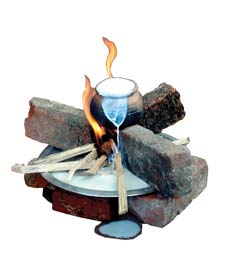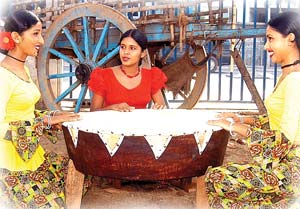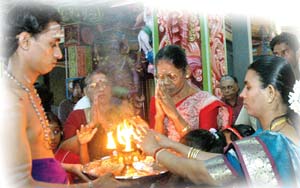|
The Sinhala and Hindu New Year :

Are you eagerly awaiting the dawn of the New Year? The answer would
be a loud, yes, no doubt. Everyone likes to usher in a new year,
especially children considering all the fun-filled and exciting
activities that go with it. The various traditional games, the new
clothes and presents, the delicious mouth-watering food, visits to
relatives' homes and fireworks are all part and parcel of the New Year
celebrations that we all enjoy.
 The Sinhala and Hindu New Year, therefore is special to many of us.
Long before we even start to think of it, the birds of the season, the
Asian Koels or kohas, as they are known in Sinhala, remind us about it
with their melodious call every morning. But, it is not just the kohas
that alert us to the fact that the New Year is upon us; the sweet
fragrance of erabudu blossoms (wherever the trees may be found) and the
aroma of freshly made traditional Avurudu sweetmeats such as kevum,
kokis and athiraha are all reminders that once again it's time for us to
celebrate another New Year! The Sinhala and Hindu New Year, therefore is special to many of us.
Long before we even start to think of it, the birds of the season, the
Asian Koels or kohas, as they are known in Sinhala, remind us about it
with their melodious call every morning. But, it is not just the kohas
that alert us to the fact that the New Year is upon us; the sweet
fragrance of erabudu blossoms (wherever the trees may be found) and the
aroma of freshly made traditional Avurudu sweetmeats such as kevum,
kokis and athiraha are all reminders that once again it's time for us to
celebrate another New Year!
Both Sinhalese and Hindus celebrate the New Year, which is usually
ushered in, in the month of April at an auspicious time given by the
astrologers, in a festive manner.
Age-old customs and rituals are observed during this festive
celebration by both communities. So, this year, we could make the New
Year, the platform to foster peace among the people of both communities
by celebrating it in harmony. With the ethnic war virtually over, we
should now make an attempt to start afresh, putting all the differences
that once drifted us apart, behind us. As we are all citizens of Mother
Lanka, we should join hands to foster peace and harmony in our
motherland.
As we usher in the New Year at the auspicious time, lighting the
traditional oil lamp, let the light spread throughout our motherland too
and
illuminate the lives of everyone of us.
The Sinhala and Hindu New Year is a time to rejoice, so, fill your
hearts with peaceful thoughts as you await the dawn of this special day
on April 14. Try to observe the age-old customs and rituals which are a
part of our rich cultural heritage. If you are not familiar with them,
find out what they are and why they are observed. It is very important
to know them even if you don't observe them.
We wish our readers a peaceful and prosperous New Year!
Some traditional games
Many games are played during the New Year and even though we may not
be in the practice of organising such games in the cities and suburbs
most of these traditional games are still played in villages. Let's
check out some of these age-old games. Perhaps you might like to play
some of them with your friends and family in the coming new year.
* Pancha is a game played using five small sea shells, a coconut
shell and a chart. How many of you are familiar with this traditional
Avurudu game?
* Olinda keliya is played mostly by women, using olinda seeds or
maditee, mee and kukuna seeds.

They also sing olinda kavi during the game. However, though this has
become a traditional game today, its roots are believed to be in
Bangladesh. There is a special stool used for this game with two
separate columns comprising seven holes in a row.
* Gudu keliya and Pora pol gaheema are two other popular games. The
former is very popular among children and many of you must be familiar
with the rules of the game.The latter is played by two teams using
coconuts with each taking turns to throw a nut until all the nuts are
broken. It is said to be popular in the southern parts of the country,
especially in Matara and Devundara.
Some of the other games played are, kalagedi sellama, onchili padeema,
kotta pora (pillow fighting) lanu edima (tug-o-war) and otthe-iratte
(believed to be one of the oldest games played).
Perhaps, in these times where ethnic harmony has to be fostered,
these traditional games could play a role in bringing people together.
Auspicious colours
You may be wondering why each year the colour of the clothes you are
supposed to wear on New Year's day changes.
The colour for the specific year is determined by the day on which
the New Year falls each year. For example, if the New Year falls on a
Sunday the colour would be copper or something close to this colour that
you will be required to wear.If it falls on a Monday - the colour would
be pearl or white. On a Tuesday, it would be red, Wednesday, green,
Thursday, gold, Friday, multi-coloured and on Saturday both black and
blue.
The auspicious colour for this year is pearl (white). It has been
decided by the astrologers based on the auspicious time for this New
Year and not according to the days of the week, this year.
What auspicious times are
All activities connected with the Sinhala and Hindu New Year
celebrations are done according to auspicious times. Many strictly
adhere to these times while some don't.
Even though we celebrate the new year of the modern European or
Gregorian calendar (so called because it was introduced by Pope Gregory
XIII) on December 31 at the stroke of midnight, the Sinhala and Hindu
New Year is not celebrated on a specific day in April at the stroke of
midnight.
The Sinhala and Hindu New Year or Avuruddha as it's called in Sinhala,
is based on a solar year; when the Sun completes a full round of the
zodiac. Some of you must be familiar with the 12 zodiac signs.
Astrologers refer to the 12 equal parts it has been divided into as
raasis. And accordingly, the time the Sun takes to pass all these 12
raasis marks a calendar year. The Sun's journey is said to begin at
Meena rasi (Aries) and end with Mesha (Pisces).
The Sun's journey from Pisces to Aries to begin another cycle of the
zodiac varies from year to year and is known as the Sankranti.
Astrologers calculate the exact time it happens, to the minute. The
interval between the time the Sun leaves Pisces to enter Aries is called
the Punya Kalaya or Nonagatha (a time of no action). Most people use
this time period to do meritorious acts.
Auspicious times
Viewing the New Moon
The New Moon should be viewed for the solar year on Monday March 30
and for the lunar year Monday April 27.
Bathing for the old year
April 11 Saturday
Should be done after anointing with a lotion made of Kapok (dimbul)
leaves
Dawn of the New Year
April 14, Tuesday at 00.47 am
The Punya Kalaya, time for engaging in religious observances falls on
April 13 between 6.23 pm to 7.11 am on April 14. Partaking in meals for
the New Year should be done before 6.23 pm on April 13. The first half
of the Punya Kalaya falls from 00.47 am to 7.11 am. Starting work,
financial transactions and partaking in meals should be done at the
following times.
Lighting the hearth and cooking the first meal
April 14 Tuesday at 5.05 am
Light the fire looking towards the north, dressed in pearl coloured
clothing. Milk rice and sweets with kothu grains should be prepared.
Starting work, financial transactions and partaking in the first meal
Should be done on April 14, at 5.50 am dressed in pearl coloured
clothing looking towards the north.
Anointing oil
April 15, Wednesday at 7.32 am
Anointing with oil holding margosa leaves over the head and kolan
leaves at the feet, dressed in green and yellow clothing. Oil and a
lotion of margosa leaves should be applied before bathing.
Leaving for work in the New Year
Leaving for employment should be done on April 20, Monday at 6.28 am
after taking a meal of milk rice mixed with seasme seed, dressed in
pearl coloured clothing.
Courtesy: Subasetha
How Hindus celebrate...
The Hindus too adhere to much austerity and rituals in the New Year
celebrations.Days before the New Year, the house is cleaned and dusted
and the front yard too is thoroughly cleaned. All members of the family
have a customary herbal oil bath at the auspicious time given by the
astrologers. This herbal mix is obtained from the nearby kovil. Then,
dressed in their new clothes, they await the New Year.

At the predetermined time, the traditional oil lamp is lit and
prayers are conducted in the family shrine room. Soon after prayers the
children prostrate in front of their elders to get their blessings. The
elders bless them by giving them money. This activity is called
`Kaivisesam'. The custom to deal with money for the first time in the
New Year, is an important event. One likes to receive money from the
person whom he/she feels would bring luck in the New Year. Most people
go to the nearest kovil where special poojas are held, during the New
Year.
Then, a family meal consisting of sweet rice and many others
delicious sweetmeats is served.
Since going to the kovil is part of the day's observances, it is
customary to abstain from non-vegetarian meals.
The rest of the day is spent entertaining and visiting relatives and
friends and also participating in some traditional games.
By following these traditions, the children learn to respect and
follow the guidance and the wisdom of their elders and keep themselves
away from harmful deeds. It also makes the elders feel they are wanted
and respected by their children.
The day begins with a family observation and ends with community
celebrations. It is the spirit of the community and neighbourly
relationships that receive very special consideration on Hindu New Year
Day. |

